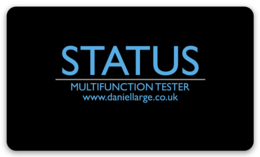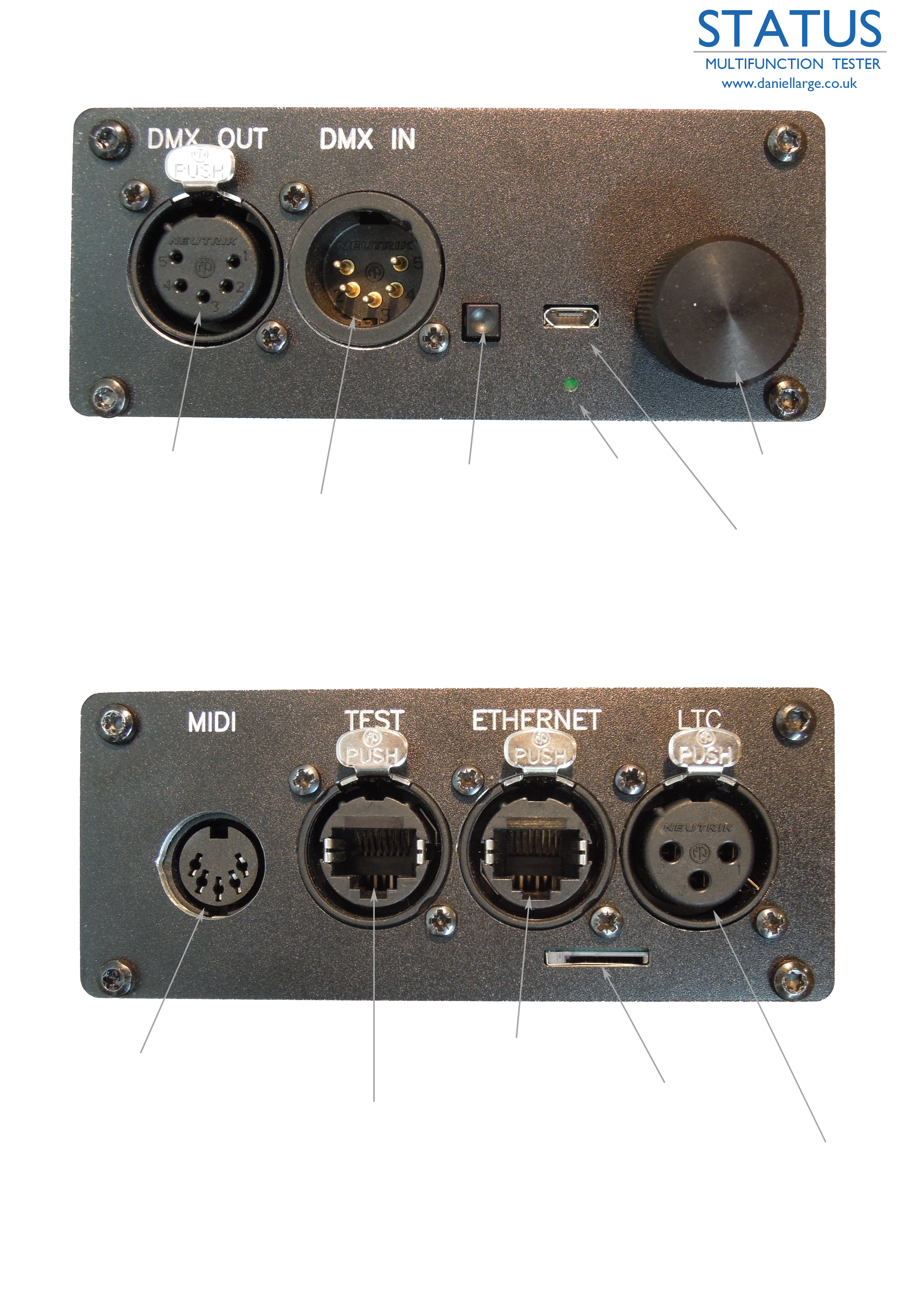
STATUS is a veritable swiss army knife of a tester. At the other end of the scale to the STATE, this device tests, measures, controls, pings and checks many of the protocols in use in the entertainment today.
The aim behind all the different modes it easier to make modern lighting systems talk to each other, and find out what the problem is when they don’t without the need for digging out a laptop and that ethernet adaptor you can’t find.
A number of features take it beyond just a tester. The “node” “dongle” modes turn it into a useful device for getting you out of trouble. Record and playback across protocols. The large screen makes it a useful LTC clock if that is your need. There are contact closure inputs for remotely firing memories or OSC commands.
The device has a 4.3″ touch screen and clicky encoder for user input, and a number of proper Neutrik connectors for getting signals in and out.
Charges from a USB micro B phone charger, and can also run plugged in.
A full list of features can be found below, and more will evolve over time. The firmware in the device can be downloaded from the internet and updated by the user.

| Specification | |
| STATUS is a multipurpose tool aimed at the live events industry. It allows a field technician to diagnose faults, test for presence | |
| of correct signals and wiring and control lighting equipment across a variety of different control protocols. | |
| The unit can be used to act as a protocol bridge in some circumstances, and data can be recorded and played back from a micro SD card. | |
| DMX, DMX RDM, ArtNET, sACN, OSC, MIDI, MTC, LTC, Contact Closure are supported at this time. | |
| The battery powered tester frees the technician from carrying around a easily damaged expensive laptop and multiple dongles. | |
| The unit also provides a computer interface for the mentioned protocols, and a suit of applications using the data will be available soon. One, the LTC display is already available – Allowing the display of SMPTE Timecode on a Mac or PC in a floating window, so values can be embedded with screen recordings, or used as a large clock readout. | |
| DMX | |
| The unit can receive and transmit DMX512, STATES can be set up by channel | |
| Scope mode; 4 channels can be views level against time on an oscilloscope style display. – helpful for diagnosing transient faults. | |
| 64 channel levels viewable at once in DMX input view | |
| Completed states can be saved to SD card for replay via DMX or any other below protocol. | |
| Replay moving scene on loop or in single snapshot | |
| RDM | |
| Discovery, Identify, Report sensors, send lamp strike/reset/douse, readdress. | |
| Send DMX with alternate start code to test for non compliance. | |
| CABLE | |
| Open and short circuits can be detected in standard wired DMX 5pin XLR cable (pins 1,2,3) | |
| Pictorial reference for ease of diagnosis. | |
| Open and short circuits can be detected in standard wired ETHERNET Cable | |
| Ethernet wiring diagram/ type indication | |
| Remote probe can be used to identify wiring when you can’t see both ends of the cable. | |
| Ethernet | |
| Protocol detector “on the wire” | |
| NTP and DHCP Test (tests for internet connectivity) | |
| CTP/LLDP – in a future software update | |
| ArtNet and sACN (E131) | |
| All features of DMX | |
| Stat page showing universes on network, framerate etc | |
| Send to any Universe, by channel or fixture. | |
| Save a Universe to memory (SD card) or All incoming universes to a memory. (selectable) | |
| Tools | |
| sACN node mode ( IN to DMX or Out to DMX) | |
| ArtNET node mode (IN to DMX or Out to DMX) | |
| USB dongle mode computer to DMX/ART/SACN | |
| OSC | |
| Receive and display incoming strings on a adjustable port & IP | |
| send test string which is also saved internally. The string is also send on closure of contact 1 | |
| MIDI | |
| Input log, shows incoming data on inbult 5pin DIN connector | |
| MSC decode, decodes MSC into human readable Cue numbers etc | |
| Midi output to send notes on/pff, pitch and velocity changes. | |
| Ping | |
| Ping a device on the local network. Selectable “to” and “from” IP addresses | |
| MTC | |
| Display Midi timecode and frame rate | |
| LTC | |
| Display SMPTE Linear Timecode (LTC) and frame rate from inbuilt 3pin XLR | |
| Display average incoming signal level in mV and on bargraph | |
| MAC and PC App to display LTC in a floating window (for screen recordings, TC tagging, larger clock displays etc) – Done | |
| PLAYBACK | |
| Playback saved memories to DMX, ArtNet and sACN. Regardless of where they came from. | |
| Streaming data can be recorded and played back at its original frame rate, a show can be recorded and playback looped. | |
| SWITCH | |
| Contact closure x 6 to all output protocols including OSC. | |
| Debug | |
| The USB on the device outputs serial which can be viewed in any terminal program, providing an all protocols to serial adaptor for logging projects etc. | |
| Could be used to timestamp with LTC for example, or view incoming MSC commands over the course of a day. | |
| HARDWEAR | |
| Encoder for rapid level setting (clickable to jump 0,50,100%), encoder also selects universes etc. | |
| Touchscreen | |
| Rechargeable Lithium Polymer battery, charges via micro usb B, using supplied cable. | |
| Robust extruded aluminium case | |
| XLR 5 pin Male DMX | |
| XLR 5 Pin Female DMX | |
| XLR 3 Pin Female (LTC) | |
| DIN 5pin (MIDI) | |
| Ethercon RJ45 Socket (ArtNet,sACN,Ping,OSC) and additional test socket, remote probe available as an accessory. | |
| MicroSD – fixture library and saved states – editiable via any text editor. | |
| Full battery monitoring (an improvement from STATE R3!) | |
| Firmware is user updatable. | |
